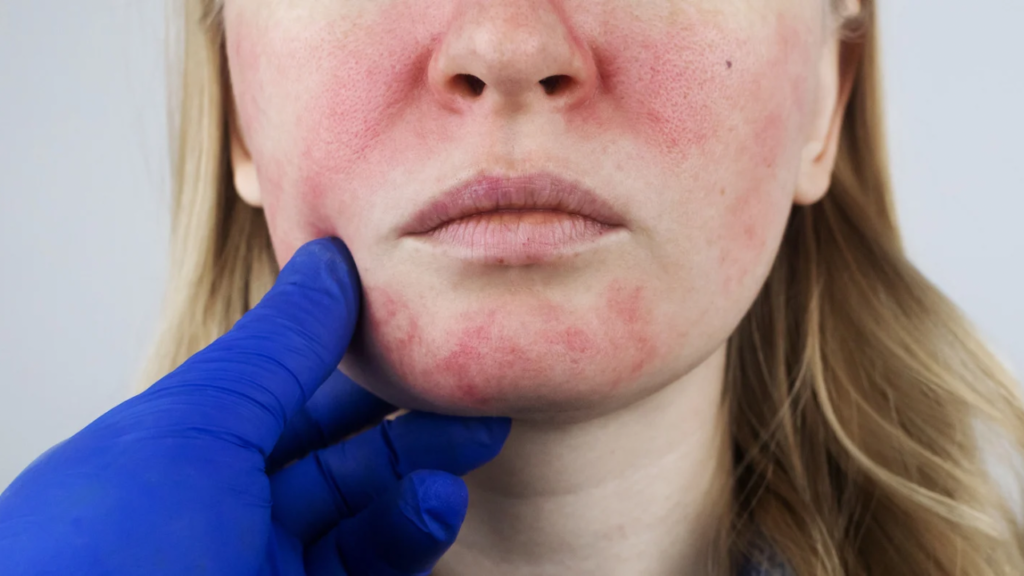
April is Rosacea Awareness month, so I figure it’s the perfect opportunity to raise awareness to this super common and chronic skin condition. Most commonly seen characteristics are redness, flushing, and visible blood vessels. Sometimes it is accompanied by oiliness along with tiny bumps or pimples. Rosacea can be very tricky because it looks different for everyone and the cause remains unknown.
It is likely attributed to a combination of genetics and environmental factors. Varying things can be triggers such as, stress, smoking, exercise, certain medications, sun exposure, heat, spicy foods, and alcohol- a lot of fun stuff, I know. Some even believe an overactive immune system could play a role. Also for whatever reason it is also more commonly seen in women and those with fair skin.
A lot of newer medical research is linking rosacea to other health conditions, all of which relating back to one of our favorite, though relevant, buzzowords: INFLAMMATION. It has also been connected to migraine and GERD (gastroesophageal reflux disease) sufferers. However, it is important to note these are all hypothesized theories.
Much like acne, this is a condition that is CONTROLLED and NOT CURED. Certain methods can keep symptoms at bay, but it is likely to go through cycles of remission, meaning it can both get better or flare back up, and go back and forth between the two.
I actually encounter rosacea a lot in the treatment room, and it’s one of my favorite challenges to tackle. I just find it so interesting that for a condition that is SO COMMON, it is still shrouded with a lot of mystery. This is inevitable since it is still so misunderstood and misdiagnosed, considering A LOT of conditions could look like rosacea. Considering I am NOT a dermatologist, I prefer to treat it as I would any inflammation, and have been lucky to see a lot of success with my clients.
Since those with rosacea or inflammation tend to have more sensitive skin, it is important to keep actives mild and regimens simple. We really want to provide barrier support because any redness being present tells us something is unbalanced. Functional hydration is a key component to barrier support. As well as antioxidants and niacinamide as they have amazing anti-inflammatory properties.
My favorite products for rosacea, redness, and inflammation include but are not limited to: Skinbetter’s Mystro Active Balance Serum, ZO Skinhealth’s Rozatrol and Soothing Hydro Mist, plus a little birdie told me these should be getting their seal of approval from the National Rosacea Society soon! I also love Hydrinity’s Hyacyn Active for its antibacterial and anti-inflammatory ingredients and Hydrinity’s Restorative HA for its healing and hydrating benefits. Supplementing any of those heavy hitters with the right cleanser and moisturizer and OF COURSE and SPF, and you should see some vast improvements in the balance and appearance of your skin.
When it comes to skin and especially inflammation, oftentimes we also need to address it from the inside out. This is why I love that Skinbetter has come out with the BioRewind supplement. It is an antioxidant supplement that addresses glycation. Glycation is essentially when sugar molecules attach to proteins, such as collagen and elastin. It contributes to inflammation, aging skin, dullness, redness, and rough texture. BioRewind works to help somewhat reverse this process resulting in healthier skin. I think this would be a great aid to those with any inflammatory skin conditions!
Believe it or not, I have also found great success with microneedling for my rosacea clients, and I believe it’s because it really helps provoke that important cell communication necessary for optimal skin function. As I said, a lot of this comes down to inflammation, so once we help our skin perform better, everything that is out of balance should regulate itself.
Also, while I do not perform laser treatments I have seen patients at Exhibit have beautiful results with the BBL laser. BBL essentially uses light energy to help improve redness, pigment, visible blood vessels, and skin tone. It’s a super quick and easy treatment, and is very tolerable. You don’t need to numb or anything, and rarely have any downtime. I also recently did this treatment for the first time to treat redness as well. I have never been told I have rosacea but I do flush easily, tend to have redness, and a few broken vessels around my nose. I am so excited to do more treatments because I have seen great improvements after just one session so far!
I would also recommend doing some calming customized facials to aid in skin function and barrier support. Also, just so you can better monitor your condition, and you and your aesthetician can help find your triggers together, and track your progress. Be sure to note anything that you believe triggers your flare ups, because again, this is a very fussy condition, the better we understand it, the better we can treat it.
So if you’re suffering from rosacea, don’t let it make you see red. Take note of what induces symptoms. Work with an aesthetician to use a good quality regimen and discuss what treatment plan may be best for you. Most importantly, be patient. The truth of the matter is, when it comes to treating anything, especially a condition as finicky as rosacea, there will be a lot of trial and error. I say it all the time but understand that all skincare is a marathon and not a sprint. Quick fixes are often too good to be true. Commitment to consistency and avoiding triggers will be the key to your success.
Stay positive and don’t be discouraged, you got this.
